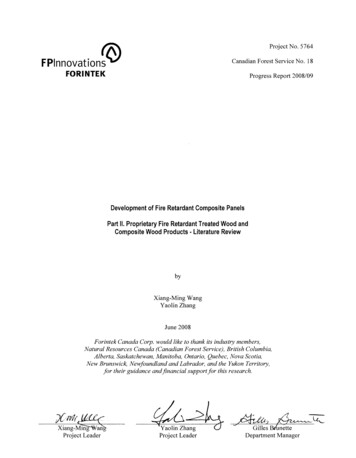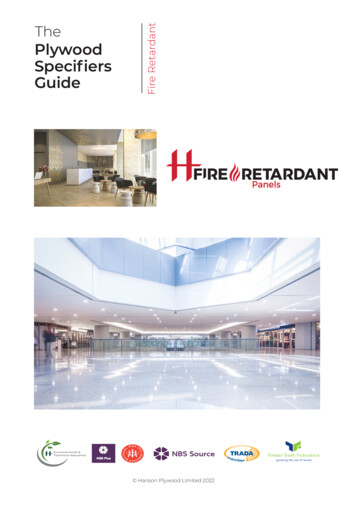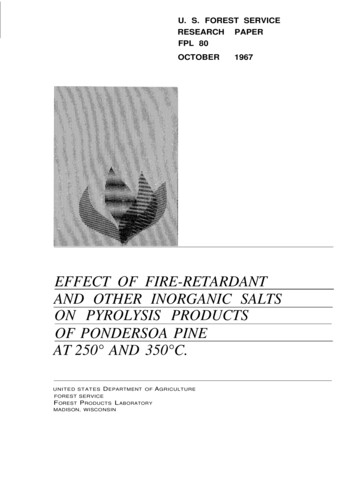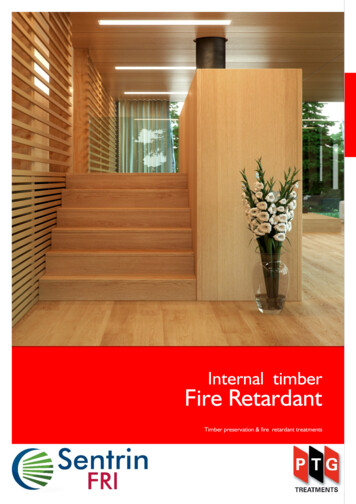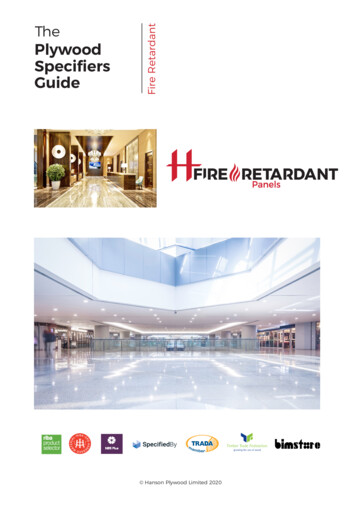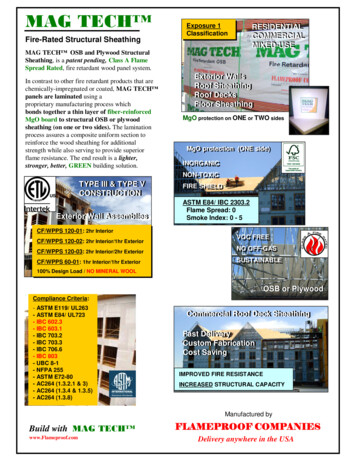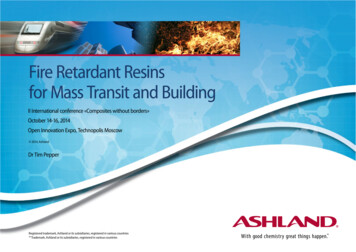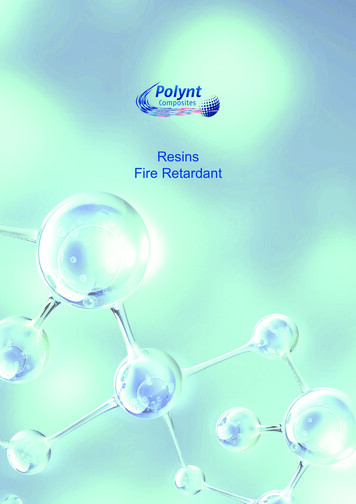
Transcription
ResinsFire Retardant
POLYNT COMPOSITESGlobal leaderfor thermoset compositesContents1. Polynt Reichhold Group.22. Introduction to the Fire Retardant System.33. Railway standards.84. Company Addresses.10Polynt Reichhold GroupAfter the merger on May 2017 the new Polynt-Reichhold Group is a global Company in the Intermediates,Coating and Composite Resins, Thermoset Compounds, Gel-coats and niche Specialties.This combination enhances the Group’s leading position as a global vertically integrated specialty chemicalsplayer, with significant global presence in Europe, North America and Asia, a strategy initiated by Polynt withthe successful integration of PCCR and CCP in the last years and now further reinforced by Reichhold’s globalscale, extensive product portfolio and R&D competencies.Polynt-Reichhold Group is known for its superior quality and impressive range of products and with itsexcellent distribution network it can provide first-class service to customers whatever their market. CustomerService and Technical Service teams are renowned for their customer focus, offering the best service evenafter products have left manufacturing.The Group strives to keep customers satisfied, assisting them in producing premium quality products everytime they use its products.Product innovation is important for the Group’s business and it’s the reason for which it constantly works withcustomers to find solutions to problems.Introducing new or improved products ensures that Polynt-Reichhold Group continue not only to deliver whatthe market wants and needs, but also when it is wanted and needed.2
Introduction to the Fire Retardant SystemFire triangleThe triangle illustrates the three elements a fire needs to ignite: heat, fuel,and oxygen. A fire occurs when those 3 elements are present and combined in the right mixture. A fire can be extinguished by removing any oneof the 3 elements.As a result, different physical processes need to be considered for fireretardant: Cooling: endothermic decomposition reaction of the flame retardantadditive that causes a decrease in the temperature needed tomaintain combustion, thus limiting the emission of combustible gas by the polymer. Dilution: a release of inert gases (CO2, NH3, H2O, etc.) from the thermal decomposition of additivescontributes to the dilution of combustible gases below the ignition threshold. Formation of a protective layer: some flame retardants lead to the formation of a solid protective layerlimiting the transfer of heat and mass between the polymer and the flame.The fire retardants and their mode of actionThere is no single solution for fireproofing materials. Different options can be used alone or in combination(cooling, inhibition of combustion reaction, thermal protection) in order to achieve the target. However, it isimportant to find the best compromise between improved fire resistance and other requirements such asmechanical properties, weather resistance (water, UV), economic feasibility and environmental issues.These fire retardant options are: Halogenated compounds: Brominated derivatives are the most effective. Very often associated withantimony oxides (synergy), halogenated derivatives exhibit a chemical mode of action mainly in the gasphase. Their performance, which is efficient at even relatively low content, is characterized by thegeneration of opaque and toxic fumes during combustion. Metal hydroxides: mainly aluminium trihydrate, which acts as both a flame retardant and a smokesuppressor. The resulting performance is interesting, but to be effective, these compounds must be usedin very large quantities, often greater than 50% in mass, which will result in a significant decrease ofmechanical characteristics and an increase in density and difficulty of wetting. Phosphate and nitrogen compounds: phosphorus derivatives have the ability to form a protective layerwhen the polymer burns, thus limiting the supply of oxygen and energy to the fuel. Ammoniumpolyphosphates have the advantage of combining the action of phosphoric acid with that of nitrogen inthe gas phase. Intumescent systems: intumescence is the ability of a material to develop a carbon shield of such thicknessthat gas and heat transfers are limited. The recipes involve an acidic substance, an inflating agent and acarbon source that leads to the formation of a «char» when the temperature of the polymer rises. It helpsto limit the spread of fire by blocking the passage of smoke, flame and heat while giving the product alower density than common charged systems.3
Inhibition in Gas Phase(smoke/toxicity)IntumescentCondensed PhaseCarbon CharImages given by CREPIM.The table in central pages of this brochure shows the type of fire retardant for each listed product: HF - Halogen Free; H - Halogen; I - Intumescent; FI - Filled.StandardsA large number of standards exist because fire risk level depends on the environment the components aregoing to be exposed to (the risk class being related to the evacuation conditions).A direct comparison of individual national tests and associated classifications with the European Standards isvery difficult because it could be subject to different interpretations of the various ratings.4
A typical example is represented by below table comparing the most commonly used Standards for the Building Industry in Europe:EuroclassGermanEN 13501-1DIN 4102-1A1A1A2 - s1, d0A2No SmokeB/C - s1, d0A2/B/C - s2/ s3/,d0A2/B/C - s1, d0/d1B1No dropletsUK(Engl.,Wales, N.I.)EuroclassFrenchEuroclassEN 13501-1NF P92-507EN 13501-1A1noncombustibleA1noncombustibleA2 - s1, d0M0A2 - s1/s2/s3,d0/d1B - s1/s2/s3,d0/d1A2 - s1/s2/s3/, d0/d1/d2limitedcombustibleM1B - s1/s2/s3/,d0/d1/d2Class 0C - s1/s2/s3,d0/d1M2C - s1/se/s3/,d0/d1/d2Class 1D - s1/s2/s3/,d0/d1/d2Class 3BS 476/6BS 476/7A2/B/C - s3, d2D - s1/s2/s3/,d0D - s1/s2/s3/,d1/d2B2EFD - s1/s2/s3/,d0/d1D - s1/s2/s3/,d0/d1M4(no droplets)EM4M2E - d2B3FEFReaction to fire classification: B - s1, d0Main indicator; fire classification.From highest rating A1 via A2, B, C, D, E to F being the lowest level of performance.BAdditional indicator; smoke production.From highest classification s1 via s2 to s3 being the lowest level of performance.s1Additional indicator; burning droplet foming.From highest classification d0 via d1 to d2 being the lowest level of performance.d0EuroclassClassification for smoke or dropletsA1Not inflammables1No smokeA2Almost not inflammables2Limited smoke poduction and smoke increaseBVery difficultly inflammables3No limitation on smoke production requiredCModerately inflammableDWell inflammabled0No droplets allowedEVery inflammabled1No droplets for longer than certain time givenFExtremely inflammabled2No limitation on droplets rquired5
CONE CALORIMETERHL320,393/4519,7Class 2105DION FR 800-200HLU-SUFI-H-12DION FR 820-034Cont. LaminateH-149DION FR 820-080Cont. LaminateH-152-131DION FR 820-606INFUSIONHUIC Kodex564-2 App 4ISO 5660SMOKE CHAMBERD-S3,d 0ISO 5659-2CFEF1EN 45545M2CLASSIF.DIN 5510EN 45545-2-2013NORPOL MTI 10176S4, SR2, ST2Fire prevention and firefighting regulationsfor rail vehicles used ininternational trafficEUROPEEN 13501-1NORPOLSVXGermanyDIN 4102-FI-HFASTM E84FI-HFHLU-SUUSABS 476 part 7HLU-SUUKBS 476 part 6DION FR 7721-00DION FR 7721-00SpainISO 5658-2NFP 16-101ProcessHF (Halogen Free)H (Halogen)I (Intumescent)FI (Filled)REFERENCENFP 92-501Type of GelcoatFranceUNE 23.727-9Type of resinRAILWAYSStandards linked(DIN 53438 /53837/4102/50050-2)BUILDINGClass BS 4, SR2, ST2SVGNORPOL NGA X2DION FR 820-M723Cont. LaminateHDION FR 820-M878HLU-SUFI-H DION FR 840-820HLU-SUFI-HDION FR 840-850HLU-SUFI-H -113-M1NORPOL GI 10176M1F2Class 167-71DION FR 844-030Cont. LaminateH-DION FR 850 seriesHLU-SUFI-HF-DION FR 850-700HLU-SUFI-HFDION FR 850-M850HLU-SUFI-HFClass 174-S4, SR2, ST2NGA HX3Class 2-135DION FR 852-700 DION FR 9300-00HLU-SUHLU - Fil.WindingFI-HFHHLU-SUClass ANGA HX3S4, SR2, ST2S4, SR2, ST2NORPOL MTI 10176S4, SR2, ST2-Class 23 % ATOClass 1Class 29935% ATHDION FR 9300-890HLU-SUFI-H-ENYDYNE H 68180 TAHLU-SUnot FR-ENYDYNE H 68372 TAHLU-SUnot FR-ENYDYNE H 68377 TAEHLU-SUnot FRClass AF3-ENYDYNE H 86181 TFHLU-SUFI-HPOLYCOR2335ENYDYNE H 86291 TFHLU-SUFI-HPOLYCORM1-Class B2M2F1S4, SR2, ST2HL2M1F230,0240/14166B-S3, d0S4, SR2, ST2ENYDYNE H 89295 FAHLU-SUFI-HF-M2F1S4, SR2, ST2ENYDYNE H 89396 FAHLU-SUFI-HF-M2F1S4, SR2, ST2ENYDYNE I 69473 ARTMnot FRPOLYCOR2335EPOVIA KRF 2000HLUH-M2F3NORSODYNE H 13372 TAHLU-SUnot FRPOLYCOR2335NORSODYNE H 25375 TAEHLU-SUnot FR-NORSODYNE H 81269 TFHLU-SUFI - I - Class B2POLYCOR2220B-S1,d0POLYCOR2335S4, SR2, ST2Classic Gelcoat ATH109Polycor 2330 M1NORSODYNE H 81381 TFAHLU-SUFI-I-HFPOLYCOR2335F1M1F2M2F484POLYCOR2335 Paint*NORSODYNE H 84233 LHLUH-NORSODYNE H 88203 TAFHLU-SUFI-H-NORSODYNE H 88204 TAFHLU-SUFI-H-Class 1NORSODYNE H 88222 TAHLU-SUFI-H-Class 2FI-I-HFPOLYCOR2335 PA ROVICORNORSODYNE I 81268 FRTMPRESTER 1150HLU-SUFI-HUNIGEL 11MBLANCOPRESTER 1165HLU-SUFI-HUNIGEL 2HLClass 221,0123/6377Class 1M1These results have be obtained on specimens. They are able to demonstrate the capability of our products to be compliant with the requirements.End users have to check the compliance of the laminates they make.6
DION FR 800-200HLU-SUFI-H-DION FR 820-034Cont. LaminateH-DION FR 820-080Cont. LaminateH-CSERF-3-77NF EN ISO11925-2UL94Standard for Safety ofFlammability of Plastic MaterialsNORPOL SVXUTAC n 18-502/1Ignitability of productssubjected to directimpigement of flame-FI-HFMIL R24719FMVSS 302Test method radiant panelFI-HFHLU-SUIMO MSC/Circ. IMO MSC/Circ. MIL R2167 /1006, item 3 1006, item 4MIL R7575SINGLE TESTSISO 45892:2006ASTM D 2863:2013Determination of burningbehaviour by oxygen indexHLU-SUMILITARYSPECIFICATIONVEHICULEInterior finishing materials, showingno dropletformation and a low burning rateDION FR 7721-00DION FR 7721-00IMO FTPCPart 5Guidelines on fire testprocedures for acceptanceof fire-retardant materialsfor the construction oflifeboatsProcessHF (Halogen Free)H (Halogen)I (Intumescent)FI (Filled)REFERENCEFire Test forsurface flammabilityType of GelcoatIMOThis specification coversrequirements forepoxy-based, vinyl esterresins suitable forlamination of boat hullsand other Naval applicationsType of resinMILITARYFlammability of InteriorMaterials for transportationMARINEClass 25VNORPOL MTI 10176DION FR 820-606INFUSIONHSVGNORPOL NGA X2DION FR 820-M723Cont. LaminateH-DION FR 820-M878HLU-SUFI-H-DION FR 840-820HLU-SUFI-HDION FR 840-850HLU-SUFI-HCompliantGrade ANORPOL GI 10176-V0NGA HX3DION FR 844-030Cont. LaminateH-DION FR 850 seriesHLU-SUFI-HF-DION FR 850-700HLU-SUFI-HFDION FR 850-M850HLU-SUFI-HFV0Grade ANGA HX3-DION FR 852-700HLU-SUFI-HFHLU -Fil. WindingDION FR 9300-00NORPOL MTI 10176-HHLU-SUCompliant3 % ATO35% ATHDION FR 9300-890HLU-SUFI-H-ENYDYNE H 68180 TAHLU-SUnot FR-Type A cat 1ENYDYNE H 68372 TAHLU-SUnot FR-Type A cat 1ENYDYNE H 68377 TAEHLU-SUnot FR-ENYDYNE H 86181 TFHLU-SUFI-HENYDYNE H 86291 TFHLU-SUFI-HENYDYNE H 89295 FAHLU-SUFI-HFENYDYNE H 89396 FAHLU-SUFI-HF-ENYDYNE I 69473 ARTMnot FRPOLYCOR 2335-LOI 35,6%POLYCOR 2335-CompliantPOLYCOR M1Compliant-EPOVIA KRF 2000HLUH-NORSODYNE H 13372 TAHLU-SUnot FRPOLYCOR 2335NORSODYNE H 25375 TAEHLU-SUnot FRPOLYCOR 2220NORSODYNE H 81269 TFHLU-SUFI-I-HFPOLYCOR 2335Classic Gel coat ATHPolycor 2330NORSODYNE H 81381 TFAHLU-SUFI-I-HFNORSODYNE H 84233 LHLUH-NORSODYNE H 88203 TAFHLU-SUFI-H-NORSODYNE H 88204 TAFHLU-SUFI-H-NORSODYNE H 88222 TAHLU-SUFI-H-NORSODYNE I 81268 FRTMFI-I-HFPOLYCOR 2335 PA ROVICORPRESTER 1150HLU-SUFI-HUNIGEL 11M BLANCOPRESTER 1165HLU-SUFI-HUNIGEL 2HLPOLYCOR 2335POLYCOR 2335 Paint** This has been obtained with HL2 Paint7
Railways StandardsTransportation: EN 45545 Part 2 A1: 2016 - Fire Protection on Rail VehiclesThe standard EN 45545-2 came into force in January 2018. From January 2015 to December 2017, it waspossible to use the national standards to qualify materials installed in railway vehicles. Now, all new materials are tested against the European Standard in order to guarantee the same level of security whatever thelocation in the EU.”The standard EN 45545-2 is no longer just a simple pass/fail or a classification to a single fire test;compliance depends upon the Operation/Design Categories combined with the type of Part to be producedwhich then leads to a series of requirements (parameters) from the following main three tests:1. ISO 5658-2 to measure CFE (kWm-2) or Flame Spread2. ISO 5660-1 (50 kWm-2) to measure MAHRE (kWm-2) or Heat Release3. ISO 5659-2 (50 kWm-2) FTIR to measure Ds(4); VOF4 CITG or Smoke/ToxicityThe standard calls for high performance products to be used in high risk scenarios, with a definite emphasison passenger/staff safety.1. Operation Category:- the relationship between service, infrastructure evacuation conditions OC1 Typically Surface Operation with short tunnels, such as a Tramway or Heavy Rail OC2 Typically City Metro Systems or surface rail with longer tunnels, short time to safety OC3 Typically very long tunnel sections (Alps, or Channel Tunnel), longer time to safety OC4 Special Vehicles operating mainly underground with restricted evacuation routes (ChannelTunnel Motor Vehicle Transporters)2. Design Category: A Automated Stock with no staff on board D Double Decked Rail Stock S Sleeping/Couchette Rail Stock N All Other (Standard) StockThese two parameters are linked to give a required Hazard Level (HL), each of which has a set ofrequirements (e.g. R1, R2 R3) that depend on the part to be produced. Where HL3 is the highestperformance and is typically achievable using SMC as the application HL2HL2HL2HL3OC4HL3HL3HL3HL3OperationThe Higher the Risk, the Higher the Safety Factors required: HL3 HL2 HL1There are many interior part definitions to be considered. For instance, the following all require R1compliance: IN1; IN4; IN5; IN6A; IN7; IN8; IN10B; IN12; IN13 IN15: a further three require R2 and one R3.The end user will be aware of these definitions.Results RequirementsThe key parameters are listed below with the requirements for each Hazard Level. Results are averages ofthree specimens tested to the required methods.8
Targets to be reached according to VOF4Max1200600300CITG (4 x600300150VOF4Max1200600300CITG (4 ax600300150VOF4Max1200600300CITG (4 8)Max1.20.90.75Example of classification of gel coat resin and resin aloneThe data highlighted in this brochure provides an outline explanation of the final requirements for piecesmanufactured for use in fire performance applications.The data shown within this document provides an indication and examples based on our experiences anddoes not aim to cover all thermoset application technologies. It is the responsibility of the end users to checkthe compliance of their material versus the standard.9
COMPANY ADDRESSESEUROPEFRANCESPAINPolynt Composites France S.A.Route D’Arras CS 5001962320 Drocourt - FrancePhone: 33 3 21 74 84 00Fax: 33 3 21 49 55 84email: ates@polynt.comPolynt Composites Spain, S.L.U.Avenida República Argentina, S/N09200, Miranda de Ebro - Burgos SpainPhone: 34 947 333 348Fax: 34 947 314 540email: ates@polynt.comITALYPolynt S.p.A.Via del Pruneto, 4052027 San Giovanni Valdarno (AR) - ItalyPhone: 39 055 91 281Fax: 39 055 94 3936email: contact@polynt.comPolynt S.p.A.Via Romagnoli, 2343056 San Polo di Torrile (PR) - ItalyPhone: 39 0521 812811Fax: 39 0521 813445email: contact@polynt.comNORWAYPolynt Composites Norway ASLilleborggata 4,1630 Gamle Fredrikstad - NorwayPhone: 47 69357000Fax: 47 69357001email: contact.NO@polynt.comPOLANDPolynt Composites Poland Sp. z o.o.ul. Grabska 11d32-005 Niepołomice - PolandPhone: 48 12 281 42 00Fax: 48 12 281 42 01email: contact.PLcomposites@polynt.com10UKReichhold UK Limited54 Willow Lane,MitchamSurrey CR4 4NA - United KingdomPhone: 44 20 8648 4684Fax: 44 20 8640 6432email: contact.UKComposites@polynt.comPolynt Composites UK Ltd.Laporte RoadStallingborough - Near GrimsbyNorth East Lincolnshire DN41 8DRUnited KingdomPhone: 44 1469 552570Fax: 44 1469 552597email: contact.UKComposites@polynt.com
This brochure is intended to provide a comprehensive list of the products and services available from all business sectors in whichare active the companies and/or corporations controlled, directly or indirectly, by Specialty Chemicals International Ltd (hereinafter referred to as «Polynt Group»). The information, recommendations, answers and/or opinions contained herein (which must beintended only for explanatory purposes) are aimed to assist customers on the basis of our technical and scientific knowledge asof today, taking into account that our products are intended for sale to industrial and commercial customers. However we requirecustomers to inspect and test our products before use and to satisfy themselves as to contents and suitability for theirapplications: nothing herein shall constitute or shall be deemed to be any other warranty or a representation, express or implied,including merchantability or fitness for a particular purpose or results to be obtained from the use of such information, nor shall betaken or construed as infringing of any existing patents. Product names in capital letters are registered trademarks of the relevantmember of Polynt Reichhold Group. Polynt S.p.A. - September 202111
Polynt Composites USA Inc.99 East Cottage AvenueCarpentersville, IL 60110United StatesPhone: 1 800 322 8103email: contact.US@polynt.comwww.polynt.comPolynt S.p.A.Via Enrico Fermi, 5124020 Scanzorosciate (BG)ItalyPhone: 39 035 652 111email: contact.IT@polynt.comwww.polynt.com
These fire retardant options are: Halogenated compounds: Brominated derivatives are the most effective. Very often associated with antimony oxides (synergy), halogenated derivatives exhibit a chemical mode of action mainly in the gas phase. Their performance, which is efficient at even relatively low content, is characterized by the
